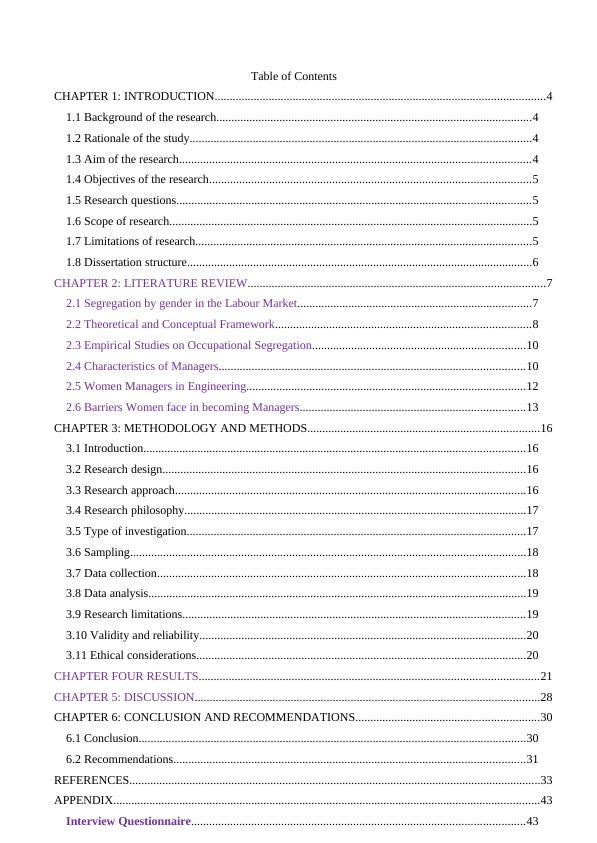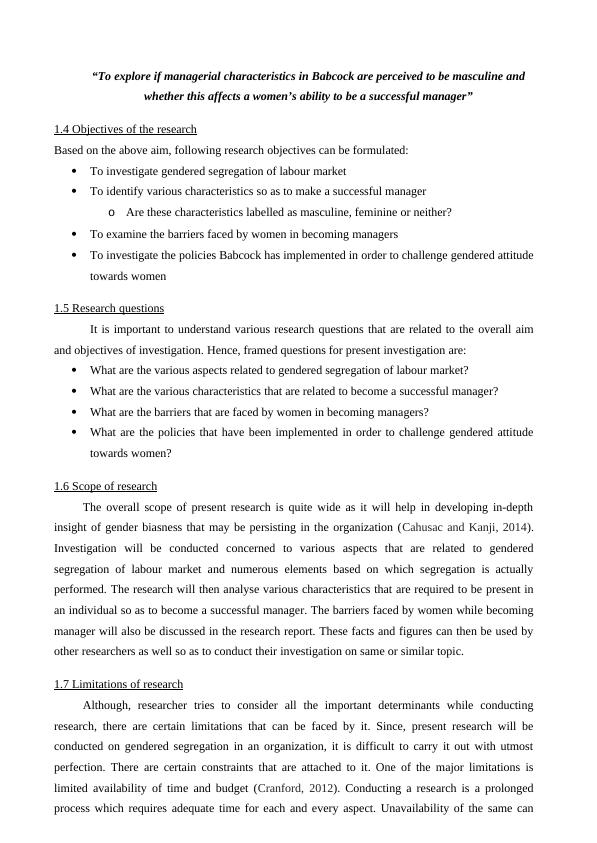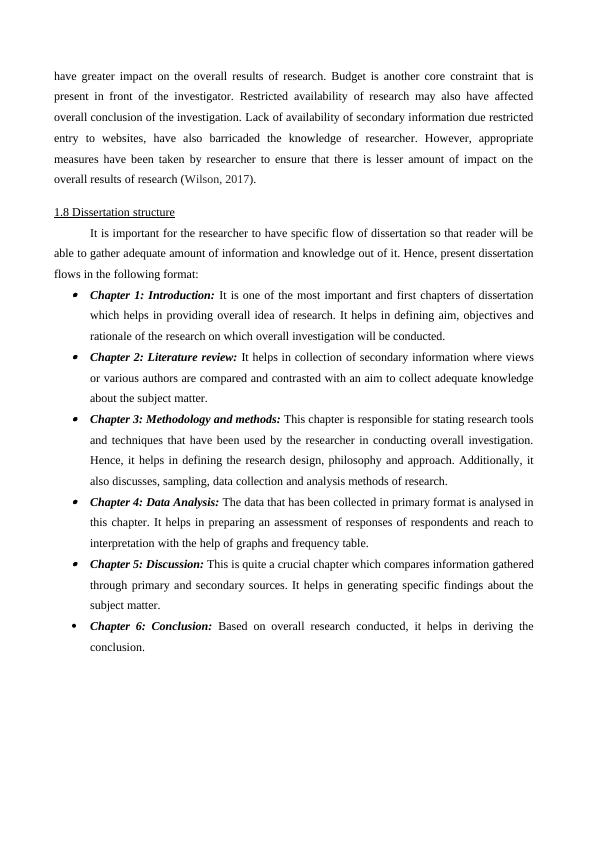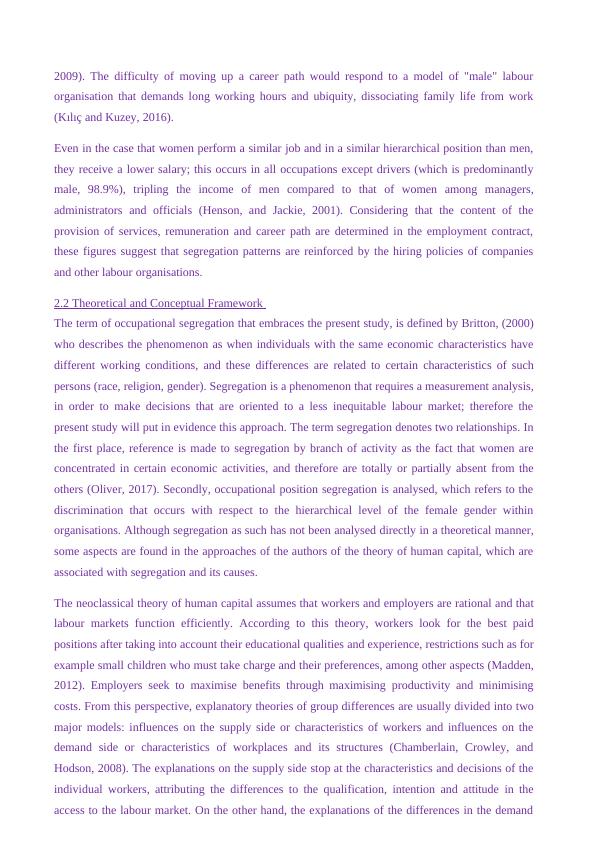Gender Segregation in the Labour Market
50 Pages20501 Words482 Views
Added on 2020-12-10
Gender Segregation in the Labour Market
Added on 2020-12-10
ShareRelated Documents
To explore if managerial
characteristics in Babcock are perceived
to be masculine and whether this a
characteristics in Babcock are perceived
to be masculine and whether this a

Table of Contents
CHAPTER 1: INTRODUCTION..............................................................................................................4
1.1 Background of the research.........................................................................................................4
1.2 Rationale of the study..................................................................................................................4
1.3 Aim of the research.....................................................................................................................4
1.4 Objectives of the research...........................................................................................................5
1.5 Research questions......................................................................................................................5
1.6 Scope of research.........................................................................................................................5
1.7 Limitations of research................................................................................................................5
1.8 Dissertation structure...................................................................................................................6
CHAPTER 2: LITERATURE REVIEW...................................................................................................7
2.1 Segregation by gender in the Labour Market..............................................................................7
2.2 Theoretical and Conceptual Framework.....................................................................................8
2.3 Empirical Studies on Occupational Segregation.......................................................................10
2.4 Characteristics of Managers......................................................................................................10
2.5 Women Managers in Engineering.............................................................................................12
2.6 Barriers Women face in becoming Managers...........................................................................13
CHAPTER 3: METHODOLOGY AND METHODS.............................................................................16
3.1 Introduction...............................................................................................................................16
3.2 Research design.........................................................................................................................16
3.3 Research approach.....................................................................................................................16
3.4 Research philosophy..................................................................................................................17
3.5 Type of investigation.................................................................................................................17
3.6 Sampling....................................................................................................................................18
3.7 Data collection...........................................................................................................................18
3.8 Data analysis..............................................................................................................................19
3.9 Research limitations..................................................................................................................19
3.10 Validity and reliability.............................................................................................................20
3.11 Ethical considerations..............................................................................................................20
CHAPTER FOUR RESULTS.................................................................................................................21
CHAPTER 5: DISCUSSION...................................................................................................................28
CHAPTER 6: CONCLUSION AND RECOMMENDATIONS.............................................................30
6.1 Conclusion.................................................................................................................................30
6.2 Recommendations.....................................................................................................................31
REFERENCES.........................................................................................................................................33
APPENDIX..............................................................................................................................................43
Interview Questionnaire...............................................................................................................43
CHAPTER 1: INTRODUCTION..............................................................................................................4
1.1 Background of the research.........................................................................................................4
1.2 Rationale of the study..................................................................................................................4
1.3 Aim of the research.....................................................................................................................4
1.4 Objectives of the research...........................................................................................................5
1.5 Research questions......................................................................................................................5
1.6 Scope of research.........................................................................................................................5
1.7 Limitations of research................................................................................................................5
1.8 Dissertation structure...................................................................................................................6
CHAPTER 2: LITERATURE REVIEW...................................................................................................7
2.1 Segregation by gender in the Labour Market..............................................................................7
2.2 Theoretical and Conceptual Framework.....................................................................................8
2.3 Empirical Studies on Occupational Segregation.......................................................................10
2.4 Characteristics of Managers......................................................................................................10
2.5 Women Managers in Engineering.............................................................................................12
2.6 Barriers Women face in becoming Managers...........................................................................13
CHAPTER 3: METHODOLOGY AND METHODS.............................................................................16
3.1 Introduction...............................................................................................................................16
3.2 Research design.........................................................................................................................16
3.3 Research approach.....................................................................................................................16
3.4 Research philosophy..................................................................................................................17
3.5 Type of investigation.................................................................................................................17
3.6 Sampling....................................................................................................................................18
3.7 Data collection...........................................................................................................................18
3.8 Data analysis..............................................................................................................................19
3.9 Research limitations..................................................................................................................19
3.10 Validity and reliability.............................................................................................................20
3.11 Ethical considerations..............................................................................................................20
CHAPTER FOUR RESULTS.................................................................................................................21
CHAPTER 5: DISCUSSION...................................................................................................................28
CHAPTER 6: CONCLUSION AND RECOMMENDATIONS.............................................................30
6.1 Conclusion.................................................................................................................................30
6.2 Recommendations.....................................................................................................................31
REFERENCES.........................................................................................................................................33
APPENDIX..............................................................................................................................................43
Interview Questionnaire...............................................................................................................43


CHAPTER 1: INTRODUCTION
1.1 Background of the research
Managers play an essential role in the business so as to guide organization towards
accomplishment of goals and objectives. Each organization tends to exist for a specific purpose and
managers are responsible for combining them to strategic activities so as to ensure that the same
has been achieved. They are responsible for combining and using organizational resources in the
best possible manner so as to generate maximum benefits out of it. Activities are designed
effectively which can thereby help in attainment of organizational goals.
Gender biasness is the common practice that can be noticed in various organizations
nowadays. Existence of major gender disparity in entities is the dominating culture of organization
in UK. Further, the ratio of females working in an organization is also quite low in comparison to
that of males. As per the reports of McKinsey & Company 2015, only one third of employees
believe that gender diversity must be top priority of their direct managers. The same study stated
that 70% of men think gender diversity to be an important aspect at the workplace (Acker, 2012).
There are only 12% women who believe that they have less opportunities for advancement. It is
due the male managers, whose decisions tend to affect diversity and equal opportunities to people,
irrespective of their genders, at the workplace.
Babcock international is a British multinational corporation which is headquartered in the
United Kingdom. It is specialised in providing support services to manage complex assets and
infrastructure in safety and mission critical environments. However, due to technicalities in
business aspects, gender biasness is quite common in Babcock. It is preferred by management to
hire males for position of managers in organization (Stainback, Kleiner and Skaggs, 2016). The
organization aims at exploring managerial characteristics in Babcock which are perceived to be
masculine and whether this affects a women’s ability to be a successful manager.
1.2 Rationale of the study
It is important for the researcher to have certain amount of relevance. It helps in ensuring that
the overall research is able to serve certain its purpose. The present research has helped in
providing in-depth insight of presence of gender biasness in the organization. It can be in terms of
position, promotion, incentives and pay scale. The investigator does not hold adequate amount of
knowledge with respect to subject matter. Hence, it will help in collecting appropriate information
regarding gender biasness in organization (Bolzendahl, 2014). Researchers, scholars and readers
will also be able to gather information that may prove to be helpful for them to conduct further
investigation later.
1.3 Aim of the research
The aim statement framed for the research is:
1.1 Background of the research
Managers play an essential role in the business so as to guide organization towards
accomplishment of goals and objectives. Each organization tends to exist for a specific purpose and
managers are responsible for combining them to strategic activities so as to ensure that the same
has been achieved. They are responsible for combining and using organizational resources in the
best possible manner so as to generate maximum benefits out of it. Activities are designed
effectively which can thereby help in attainment of organizational goals.
Gender biasness is the common practice that can be noticed in various organizations
nowadays. Existence of major gender disparity in entities is the dominating culture of organization
in UK. Further, the ratio of females working in an organization is also quite low in comparison to
that of males. As per the reports of McKinsey & Company 2015, only one third of employees
believe that gender diversity must be top priority of their direct managers. The same study stated
that 70% of men think gender diversity to be an important aspect at the workplace (Acker, 2012).
There are only 12% women who believe that they have less opportunities for advancement. It is
due the male managers, whose decisions tend to affect diversity and equal opportunities to people,
irrespective of their genders, at the workplace.
Babcock international is a British multinational corporation which is headquartered in the
United Kingdom. It is specialised in providing support services to manage complex assets and
infrastructure in safety and mission critical environments. However, due to technicalities in
business aspects, gender biasness is quite common in Babcock. It is preferred by management to
hire males for position of managers in organization (Stainback, Kleiner and Skaggs, 2016). The
organization aims at exploring managerial characteristics in Babcock which are perceived to be
masculine and whether this affects a women’s ability to be a successful manager.
1.2 Rationale of the study
It is important for the researcher to have certain amount of relevance. It helps in ensuring that
the overall research is able to serve certain its purpose. The present research has helped in
providing in-depth insight of presence of gender biasness in the organization. It can be in terms of
position, promotion, incentives and pay scale. The investigator does not hold adequate amount of
knowledge with respect to subject matter. Hence, it will help in collecting appropriate information
regarding gender biasness in organization (Bolzendahl, 2014). Researchers, scholars and readers
will also be able to gather information that may prove to be helpful for them to conduct further
investigation later.
1.3 Aim of the research
The aim statement framed for the research is:

“To explore if managerial characteristics in Babcock are perceived to be masculine and
whether this affects a women’s ability to be a successful manager”
1.4 Objectives of the research
Based on the above aim, following research objectives can be formulated:
To investigate gendered segregation of labour market
To identify various characteristics so as to make a successful manager
o Are these characteristics labelled as masculine, feminine or neither?
To examine the barriers faced by women in becoming managers
To investigate the policies Babcock has implemented in order to challenge gendered attitude
towards women
1.5 Research questions
It is important to understand various research questions that are related to the overall aim
and objectives of investigation. Hence, framed questions for present investigation are:
What are the various aspects related to gendered segregation of labour market?
What are the various characteristics that are related to become a successful manager?
What are the barriers that are faced by women in becoming managers?
What are the policies that have been implemented in order to challenge gendered attitude
towards women?
1.6 Scope of research
The overall scope of present research is quite wide as it will help in developing in-depth
insight of gender biasness that may be persisting in the organization (Cahusac and Kanji, 2014).
Investigation will be conducted concerned to various aspects that are related to gendered
segregation of labour market and numerous elements based on which segregation is actually
performed. The research will then analyse various characteristics that are required to be present in
an individual so as to become a successful manager. The barriers faced by women while becoming
manager will also be discussed in the research report. These facts and figures can then be used by
other researchers as well so as to conduct their investigation on same or similar topic.
1.7 Limitations of research
Although, researcher tries to consider all the important determinants while conducting
research, there are certain limitations that can be faced by it. Since, present research will be
conducted on gendered segregation in an organization, it is difficult to carry it out with utmost
perfection. There are certain constraints that are attached to it. One of the major limitations is
limited availability of time and budget (Cranford, 2012). Conducting a research is a prolonged
process which requires adequate time for each and every aspect. Unavailability of the same can
whether this affects a women’s ability to be a successful manager”
1.4 Objectives of the research
Based on the above aim, following research objectives can be formulated:
To investigate gendered segregation of labour market
To identify various characteristics so as to make a successful manager
o Are these characteristics labelled as masculine, feminine or neither?
To examine the barriers faced by women in becoming managers
To investigate the policies Babcock has implemented in order to challenge gendered attitude
towards women
1.5 Research questions
It is important to understand various research questions that are related to the overall aim
and objectives of investigation. Hence, framed questions for present investigation are:
What are the various aspects related to gendered segregation of labour market?
What are the various characteristics that are related to become a successful manager?
What are the barriers that are faced by women in becoming managers?
What are the policies that have been implemented in order to challenge gendered attitude
towards women?
1.6 Scope of research
The overall scope of present research is quite wide as it will help in developing in-depth
insight of gender biasness that may be persisting in the organization (Cahusac and Kanji, 2014).
Investigation will be conducted concerned to various aspects that are related to gendered
segregation of labour market and numerous elements based on which segregation is actually
performed. The research will then analyse various characteristics that are required to be present in
an individual so as to become a successful manager. The barriers faced by women while becoming
manager will also be discussed in the research report. These facts and figures can then be used by
other researchers as well so as to conduct their investigation on same or similar topic.
1.7 Limitations of research
Although, researcher tries to consider all the important determinants while conducting
research, there are certain limitations that can be faced by it. Since, present research will be
conducted on gendered segregation in an organization, it is difficult to carry it out with utmost
perfection. There are certain constraints that are attached to it. One of the major limitations is
limited availability of time and budget (Cranford, 2012). Conducting a research is a prolonged
process which requires adequate time for each and every aspect. Unavailability of the same can

have greater impact on the overall results of research. Budget is another core constraint that is
present in front of the investigator. Restricted availability of research may also have affected
overall conclusion of the investigation. Lack of availability of secondary information due restricted
entry to websites, have also barricaded the knowledge of researcher. However, appropriate
measures have been taken by researcher to ensure that there is lesser amount of impact on the
overall results of research (Wilson, 2017).
1.8 Dissertation structure
It is important for the researcher to have specific flow of dissertation so that reader will be
able to gather adequate amount of information and knowledge out of it. Hence, present dissertation
flows in the following format: Chapter 1: Introduction: It is one of the most important and first chapters of dissertation
which helps in providing overall idea of research. It helps in defining aim, objectives and
rationale of the research on which overall investigation will be conducted. Chapter 2: Literature review: It helps in collection of secondary information where views
or various authors are compared and contrasted with an aim to collect adequate knowledge
about the subject matter. Chapter 3: Methodology and methods: This chapter is responsible for stating research tools
and techniques that have been used by the researcher in conducting overall investigation.
Hence, it helps in defining the research design, philosophy and approach. Additionally, it
also discusses, sampling, data collection and analysis methods of research. Chapter 4: Data Analysis: The data that has been collected in primary format is analysed in
this chapter. It helps in preparing an assessment of responses of respondents and reach to
interpretation with the help of graphs and frequency table. Chapter 5: Discussion: This is quite a crucial chapter which compares information gathered
through primary and secondary sources. It helps in generating specific findings about the
subject matter.
Chapter 6: Conclusion: Based on overall research conducted, it helps in deriving the
conclusion.
present in front of the investigator. Restricted availability of research may also have affected
overall conclusion of the investigation. Lack of availability of secondary information due restricted
entry to websites, have also barricaded the knowledge of researcher. However, appropriate
measures have been taken by researcher to ensure that there is lesser amount of impact on the
overall results of research (Wilson, 2017).
1.8 Dissertation structure
It is important for the researcher to have specific flow of dissertation so that reader will be
able to gather adequate amount of information and knowledge out of it. Hence, present dissertation
flows in the following format: Chapter 1: Introduction: It is one of the most important and first chapters of dissertation
which helps in providing overall idea of research. It helps in defining aim, objectives and
rationale of the research on which overall investigation will be conducted. Chapter 2: Literature review: It helps in collection of secondary information where views
or various authors are compared and contrasted with an aim to collect adequate knowledge
about the subject matter. Chapter 3: Methodology and methods: This chapter is responsible for stating research tools
and techniques that have been used by the researcher in conducting overall investigation.
Hence, it helps in defining the research design, philosophy and approach. Additionally, it
also discusses, sampling, data collection and analysis methods of research. Chapter 4: Data Analysis: The data that has been collected in primary format is analysed in
this chapter. It helps in preparing an assessment of responses of respondents and reach to
interpretation with the help of graphs and frequency table. Chapter 5: Discussion: This is quite a crucial chapter which compares information gathered
through primary and secondary sources. It helps in generating specific findings about the
subject matter.
Chapter 6: Conclusion: Based on overall research conducted, it helps in deriving the
conclusion.

CHAPTER 2: LITERATURE REVIEW
2.1 Segregation by gender in the Labour Market
Despite their increasing incorporation into the labour market, women are less likely than men to
seek and obtain work (Kalev, Frank and Erin, 2006). One reason for lack of women in the
workforce is conflicts between work and family life (Leinonen et al, 2017). According to the
Mandel, (2013), women spend three times more hours per week on household chores compared to
men. Women spend more time caring for children, sick and disabled adults; the preparation of food,
and the cleaning of the home. Therefore, if the hours dedicated by men and women to paid work
are added to those dedicated to domestic work, women work longer hours than men.
The lack of representation of women in the labour market is explained by an inequitable
distribution of domestic work, the product of a model of social distribution of work according to
gender, in which men assume the role of "provider" performing "productive work" or paid work
outside the home, and women performing "reproductive work" or domestic work within the home.
The women’s work is socially undervalued because it is considered natural, inseparable and normal
for women, to the point of not really being considered a job (Kamerade and Richardson, 2017).
This model remains unchanged despite the increasing incorporation of women into the labour
market.
Women who work are concentrated in certain economic activities, such as activities extractive,
services and retail trade. According to Irvine, Leslie, and Jenny, (2010), certain occupations are
predominantly occupied by women (domestic workers, 96%, salespersons, 72%, and service
workers, 51.1%). The concentration of women in certain sectors of the economy and occupations
can also be explained in the work-sharing model, since in the labour market the roles assigned to
women are replicated and extended: care and care of people, cleaning and food preparation,
education, social relations; as well as the undervaluation of said work.
The sectors in which women's work is concentrated are generally informal, which affects the
quality of employment of women workers; in fact, underemployment affects in particular extractive
activities, retail trade and personal services (Susan, 2017). As a consequence, adequate employment
among men is much higher than among women (Huffman, Philip and Jessica, 2010). The
undervaluation of "feminine" work can even be institutionalised, as is the case with the regulation
of domestic work in a labour relationship that establishes a regime of reduced benefits compared to
the general one. To this horizontal segregation of women who work (depending on economic
activities and occupation in which they are inserted in the labour market), a vertical segregation is
added (depending on the hierarchy in which they are inserted in a labour organisation). In contrary,
in large organisations, only 6.44% of general managers are women, a percentage that rises to
15.86% in the medium-sised company and to 21.18% in the small company (Gorman, and Julie,
2.1 Segregation by gender in the Labour Market
Despite their increasing incorporation into the labour market, women are less likely than men to
seek and obtain work (Kalev, Frank and Erin, 2006). One reason for lack of women in the
workforce is conflicts between work and family life (Leinonen et al, 2017). According to the
Mandel, (2013), women spend three times more hours per week on household chores compared to
men. Women spend more time caring for children, sick and disabled adults; the preparation of food,
and the cleaning of the home. Therefore, if the hours dedicated by men and women to paid work
are added to those dedicated to domestic work, women work longer hours than men.
The lack of representation of women in the labour market is explained by an inequitable
distribution of domestic work, the product of a model of social distribution of work according to
gender, in which men assume the role of "provider" performing "productive work" or paid work
outside the home, and women performing "reproductive work" or domestic work within the home.
The women’s work is socially undervalued because it is considered natural, inseparable and normal
for women, to the point of not really being considered a job (Kamerade and Richardson, 2017).
This model remains unchanged despite the increasing incorporation of women into the labour
market.
Women who work are concentrated in certain economic activities, such as activities extractive,
services and retail trade. According to Irvine, Leslie, and Jenny, (2010), certain occupations are
predominantly occupied by women (domestic workers, 96%, salespersons, 72%, and service
workers, 51.1%). The concentration of women in certain sectors of the economy and occupations
can also be explained in the work-sharing model, since in the labour market the roles assigned to
women are replicated and extended: care and care of people, cleaning and food preparation,
education, social relations; as well as the undervaluation of said work.
The sectors in which women's work is concentrated are generally informal, which affects the
quality of employment of women workers; in fact, underemployment affects in particular extractive
activities, retail trade and personal services (Susan, 2017). As a consequence, adequate employment
among men is much higher than among women (Huffman, Philip and Jessica, 2010). The
undervaluation of "feminine" work can even be institutionalised, as is the case with the regulation
of domestic work in a labour relationship that establishes a regime of reduced benefits compared to
the general one. To this horizontal segregation of women who work (depending on economic
activities and occupation in which they are inserted in the labour market), a vertical segregation is
added (depending on the hierarchy in which they are inserted in a labour organisation). In contrary,
in large organisations, only 6.44% of general managers are women, a percentage that rises to
15.86% in the medium-sised company and to 21.18% in the small company (Gorman, and Julie,

2009). The difficulty of moving up a career path would respond to a model of "male" labour
organisation that demands long working hours and ubiquity, dissociating family life from work
(Kılıç and Kuzey, 2016).
Even in the case that women perform a similar job and in a similar hierarchical position than men,
they receive a lower salary; this occurs in all occupations except drivers (which is predominantly
male, 98.9%), tripling the income of men compared to that of women among managers,
administrators and officials (Henson, and Jackie, 2001). Considering that the content of the
provision of services, remuneration and career path are determined in the employment contract,
these figures suggest that segregation patterns are reinforced by the hiring policies of companies
and other labour organisations.
2.2 Theoretical and Conceptual Framework
The term of occupational segregation that embraces the present study, is defined by Britton, (2000)
who describes the phenomenon as when individuals with the same economic characteristics have
different working conditions, and these differences are related to certain characteristics of such
persons (race, religion, gender). Segregation is a phenomenon that requires a measurement analysis,
in order to make decisions that are oriented to a less inequitable labour market; therefore the
present study will put in evidence this approach. The term segregation denotes two relationships. In
the first place, reference is made to segregation by branch of activity as the fact that women are
concentrated in certain economic activities, and therefore are totally or partially absent from the
others (Oliver, 2017). Secondly, occupational position segregation is analysed, which refers to the
discrimination that occurs with respect to the hierarchical level of the female gender within
organisations. Although segregation as such has not been analysed directly in a theoretical manner,
some aspects are found in the approaches of the authors of the theory of human capital, which are
associated with segregation and its causes.
The neoclassical theory of human capital assumes that workers and employers are rational and that
labour markets function efficiently. According to this theory, workers look for the best paid
positions after taking into account their educational qualities and experience, restrictions such as for
example small children who must take charge and their preferences, among other aspects (Madden,
2012). Employers seek to maximise benefits through maximising productivity and minimising
costs. From this perspective, explanatory theories of group differences are usually divided into two
major models: influences on the supply side or characteristics of workers and influences on the
demand side or characteristics of workplaces and its structures (Chamberlain, Crowley, and
Hodson, 2008). The explanations on the supply side stop at the characteristics and decisions of the
individual workers, attributing the differences to the qualification, intention and attitude in the
access to the labour market. On the other hand, the explanations of the differences in the demand
organisation that demands long working hours and ubiquity, dissociating family life from work
(Kılıç and Kuzey, 2016).
Even in the case that women perform a similar job and in a similar hierarchical position than men,
they receive a lower salary; this occurs in all occupations except drivers (which is predominantly
male, 98.9%), tripling the income of men compared to that of women among managers,
administrators and officials (Henson, and Jackie, 2001). Considering that the content of the
provision of services, remuneration and career path are determined in the employment contract,
these figures suggest that segregation patterns are reinforced by the hiring policies of companies
and other labour organisations.
2.2 Theoretical and Conceptual Framework
The term of occupational segregation that embraces the present study, is defined by Britton, (2000)
who describes the phenomenon as when individuals with the same economic characteristics have
different working conditions, and these differences are related to certain characteristics of such
persons (race, religion, gender). Segregation is a phenomenon that requires a measurement analysis,
in order to make decisions that are oriented to a less inequitable labour market; therefore the
present study will put in evidence this approach. The term segregation denotes two relationships. In
the first place, reference is made to segregation by branch of activity as the fact that women are
concentrated in certain economic activities, and therefore are totally or partially absent from the
others (Oliver, 2017). Secondly, occupational position segregation is analysed, which refers to the
discrimination that occurs with respect to the hierarchical level of the female gender within
organisations. Although segregation as such has not been analysed directly in a theoretical manner,
some aspects are found in the approaches of the authors of the theory of human capital, which are
associated with segregation and its causes.
The neoclassical theory of human capital assumes that workers and employers are rational and that
labour markets function efficiently. According to this theory, workers look for the best paid
positions after taking into account their educational qualities and experience, restrictions such as for
example small children who must take charge and their preferences, among other aspects (Madden,
2012). Employers seek to maximise benefits through maximising productivity and minimising
costs. From this perspective, explanatory theories of group differences are usually divided into two
major models: influences on the supply side or characteristics of workers and influences on the
demand side or characteristics of workplaces and its structures (Chamberlain, Crowley, and
Hodson, 2008). The explanations on the supply side stop at the characteristics and decisions of the
individual workers, attributing the differences to the qualification, intention and attitude in the
access to the labour market. On the other hand, the explanations of the differences in the demand

End of preview
Want to access all the pages? Upload your documents or become a member.
Related Documents
Exploring Masculine Managerial Characteristics in Babcocklg...
|9
|2613
|70
(PDF) Women in Hotel Management and Leadershiplg...
|46
|19446
|452
